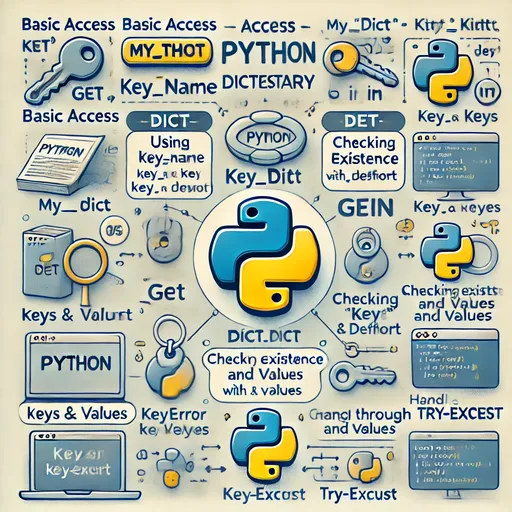Python's Dictionary is a very powerful data structure that allows you to store and manage data in key-value pairs.
From beginners to experts, Dictionaries are frequently used in Python programming. In this post, we will explore various methods to access keys in Python Dictionaries and their use cases.
1. Basic Key Access Method: variable_name[key_name]
To access a specific key in a Dictionary, the most fundamental way is to use variable_name[key_name]. This method is simple and intuitive and is used in most cases.
my_dict = {'name': 'Alice', 'age': 25, 'city': 'Seoul'}
# Directly access the key
print(my_dict['name']) # Output: Alice
print(my_dict['age']) # Output: 25
Note
If the key does not exist in the dictionary, a KeyError will occur.
my_dict = {'name': 'Alice'}
# When the key is absent
print(my_dict['country']) # KeyError: 'country'
2. Using dict.get(key, default)
The get() method allows you to specify a default value to be returned if the key does not exist. This is useful for preventing KeyErrors.
my_dict = {'name': 'Alice', 'age': 25}
# When the key exists
print(my_dict.get('name')) # Output: Alice
# When the key does not exist
print(my_dict.get('country')) # Output: None
print(my_dict.get('country', 'Korea')) # Output: Korea
The get() method returns None if no default value is specified, allowing you to safely check for keys without errors.
3. Checking Key Existence: in Keyword
To check if a specific key exists in a Dictionary, use the in keyword. This provides a safe access method and prevents KeyErrors.
my_dict = {'name': 'Alice', 'age': 25}
if 'age' in my_dict:
print(my_dict['age']) # Output: 25
if 'country' not in my_dict:
print("Key 'country' does not exist.") # Output: Key 'country' does not exist.
The in keyword is useful for simply checking the existence of keys without needing exception handling.
4. Iterating Over a Dictionary with Loops
You can use loops to iterate over all the keys and values stored in a Dictionary.
Iterating Over Keys Only
my_dict = {'name': 'Alice', 'age': 25, 'city': 'Seoul'}
for key in my_dict:
print(f"{key}: {my_dict[key]}")
# Output:
# name: Alice
# age: 25
# city: Seoul
Iterating Over Both Keys and Values
You can use the items() method to retrieve both keys and values simultaneously.
for key, value in my_dict.items():
print(f"{key}: {value}")
# Output:
# name: Alice
# age: 25
# city: Seoul
5. Exception Handling: Preventing KeyErrors with try-except
If there is a possibility that a key may not exist, you can use a try-except block to handle KeyErrors.
my_dict = {'name': 'Alice', 'age': 25}
try:
print(my_dict['country'])
except KeyError:
print("Key does not exist.") # Output: Key does not exist.
This method is useful when you need to handle errors appropriately rather than ignoring them.
Summary
There are various methods you can choose to access Dictionary keys based on the situation.
| Method | Description |
|---|---|
variable_name[key_name] |
Basic key access method. Raises KeyError if the key is absent. |
dict.get(key, default) |
Returns default value if the key is absent. Prevents KeyErrors. |
in keyword |
Checks for key existence and allows safe access. |
for loop |
Iterate through all keys and values. Use items() to access key-value pairs concurrently. |
try-except to prevent KeyErrors |
Ensures safety with exception handling where the key may not exist. |

Additional Tips
- When handling Dictionaries, choose access methods considering safety and efficiency.
- If you need to first confirm key existence, using the
inkeyword andget()method can make your code cleaner.
I hope this post on handling Python Dictionaries helps you in your development journey! 😊

There are no comments.